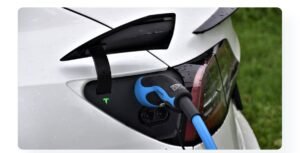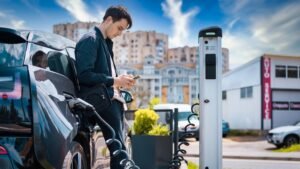The Complete Guide to Level 1 vs. Level 2 vs. Level 3 Charging for EVs

The Complete Guide to Level 1 vs. Level 2 vs. Level 3 Charging for EVs
Table of Contents
ToggleThe Complete Guide to Level 1 vs. Level 2 vs. Level 3 Charging for EVs
As electric vehicles (EVs) gain popularity, understanding the differences between charging levels is crucial. From home setups to commercial charging stations, knowing what suits your needs can save time and money. In this guide, we’ll break down the key differences between Level 1, Level 2, and Level 3 charging stations, their costs, usage, and more.
What Are EV Charging Levels?
EV charging levels refer to the power output provided by a charging station. The higher the level, the faster the charge. Let’s explore what makes Level 1, Level 2, and Level 3 chargers different.
Level 1 Charging Station: The Basic Option

A Level 1 charging station uses a standard 120-volt outlet, the same type you use to plug in household appliances. Every EV comes with a portable Level 1 charger, which is ideal for residential use.
- Power Output: 1.3 kW to 2.4 kW
- Charging Speed: Adds around 3 to 5 miles of range per hour
- Full Charge Time: Up to 24 hours for a full charge
- Cost: Minimal – comes with the EV purchase
Best For: Single-family homes and occasional EV users. Level 1 charging is slow, so it’s more suited for overnight charging.
Level 2 Charging Station: Faster Residential and Commercial Use

A Level 2 charging station requires a 240-volt outlet, which can be installed in your home or workplace. These stations charge an EV much faster and are widely used in public parking areas, shopping centers, and apartment complexes.
- Power Output: 3 kW to 20 kW
- Charging Speed: 20 to 30 miles of range per hour
- Full Charge Time: 6 to 12 hours, depending on battery size
- Cost: $300 to $1,000 for the charger, plus installation fees
Best For: Homes with a dedicated EV outlet, businesses, or commercial spaces that need to offer charging stations for customers or employees.
Level 3 Charging Station: Fastest Charging for High Demand

Level 3 charging stations, also known as DC fast chargers, are the most powerful option. These stations use direct current (DC) rather than alternating current (AC) to charge vehicles, allowing for extremely fast charging. You’ll often find Level 3 stations along highways and busy commercial areas.
- Power Output: 50 kW to 350 kW
- Charging Speed: Adds up to 20 miles of range per minute
- Full Charge Time: Under an hour for most vehicles
- Cost: ~$10,000 per charger, plus high installation costs
Best For: Commercial and heavy-duty EVs or EV fleets. These stations are great for long trips or heavy usage.
Comparison Table: Level 1 vs. Level 2 vs. Level 3 Charging Stations
| Feature | Level 1 | Level 2 | Level 3 (DC Fast Charging) |
|---|---|---|---|
| Power Output | 1.3 kW – 2.4 kW | 3 kW – 20 kW | 50 kW – 350 kW |
| Charging Speed | 3-5 miles/hour | 20-30 miles/hour | 20 miles/minute |
| Full Charge Time | Up to 24 hours | 6-12 hours | Under 1 hour |
| Cost | Minimal | $300 – $1,000 + install | ~$10,000 + installation |
| Best Use Case | Home, low mileage | Home, businesses | Commercial, high-demand |
Choosing the Right Charging Station
Selecting the right EV charging station depends on several factors, including budget, charging speed, and where the charger will be installed.
- Homeowners: A Level 2 charging station is ideal for faster, overnight charging. However, if you only drive short distances, a Level 1 charger may suffice.
- Businesses: Offering Level 2 chargers can attract EV drivers and increase customer foot traffic. If you manage a fleet or cater to commercial EVs, Level 3 chargers will be necessary.
- Public Locations: Parking lots, shopping centers, and apartment complexes benefit from installing Level 2 chargers to support EV users without the high costs of Level 3.
Costs and Installation
- Level 1: Typically comes with the EV and doesn’t require additional setup.
- Level 2: While the charger costs between $300 and $1,000, installation may involve upgrading electrical infrastructure, increasing total costs.
- Level 3: The most expensive, both in terms of hardware and installation, due to the high power output and infrastructure needs.
EV Charger Compatibility
While most EVs can use Level 1 and Level 2 chargers, not all vehicles are compatible with Level 3 charging. Level 3 requires special connectors like CCS or CHAdeMO, and smaller EVs or plug-in hybrids may not handle the higher currents safely.
Final Thoughts
Understanding the differences between Level 1, Level 2, and Level 3 charging stations can help you make informed decisions about installing the right charger. Whether you’re an EV owner looking to upgrade your home setup or a business aiming to support the growing EV market, choosing the correct charging level is key to ensuring smooth, efficient charging.
Make sure to assess your needs—whether for personal use, public locations, or commercial fleets—and choose the charging station that best fits your budget and usage requirements.
FAQ: EV Charging Stations
1. What is the difference between Level 1, Level 2, and Level 3 charging?
Level 1 uses a standard 120V outlet, charging slowly. Level 2 requires a 240V outlet and charges faster. Level 3, also known as DC fast charging, uses direct current for the quickest charge.
2. How long does it take to charge an EV?
Level 1 charging takes up to 24 hours, Level 2 takes 6-12 hours, and Level 3 can charge an EV in under an hour.
3. What is the cost of installing an EV charging station?
Level 1 charging requires no extra cost, as the cable comes with the EV. Level 2 chargers cost between $300 and $1,000 plus installation fees. Level 3 chargers cost around $10,000 plus higher installation costs.
4. Can I use a Level 3 charger for my EV?
Most EVs can use Level 1 and Level 2 chargers. However, not all EVs are compatible with Level 3 due to the need for special connectors like CCS or CHAdeMO.
5. Where can I find Level 3 charging stations?
Level 3 chargers are typically found along highways, main roads, and commercial locations where fast charging is essential.
6. What’s the best charger for home use?
A Level 2 charger is ideal for home use as it offers faster charging while being cost-effective.
Why You Need to Read These Blog
17 Coolest Tech Gadgets You Must Check Out
Born in the USA – 5 American Innovations that Changed the World
What is an AI Idea Generator and How It Can Help Your Business?
Zhuoxin Data Technology: Transforming Data Solutions for the Future
Top Authors That Have a Simplicity Writing Style: ChatGPT Prompts
Best Free AI for TikTok Content Ideas
What If You Ordered the Toktoq Set Before 5/17?






